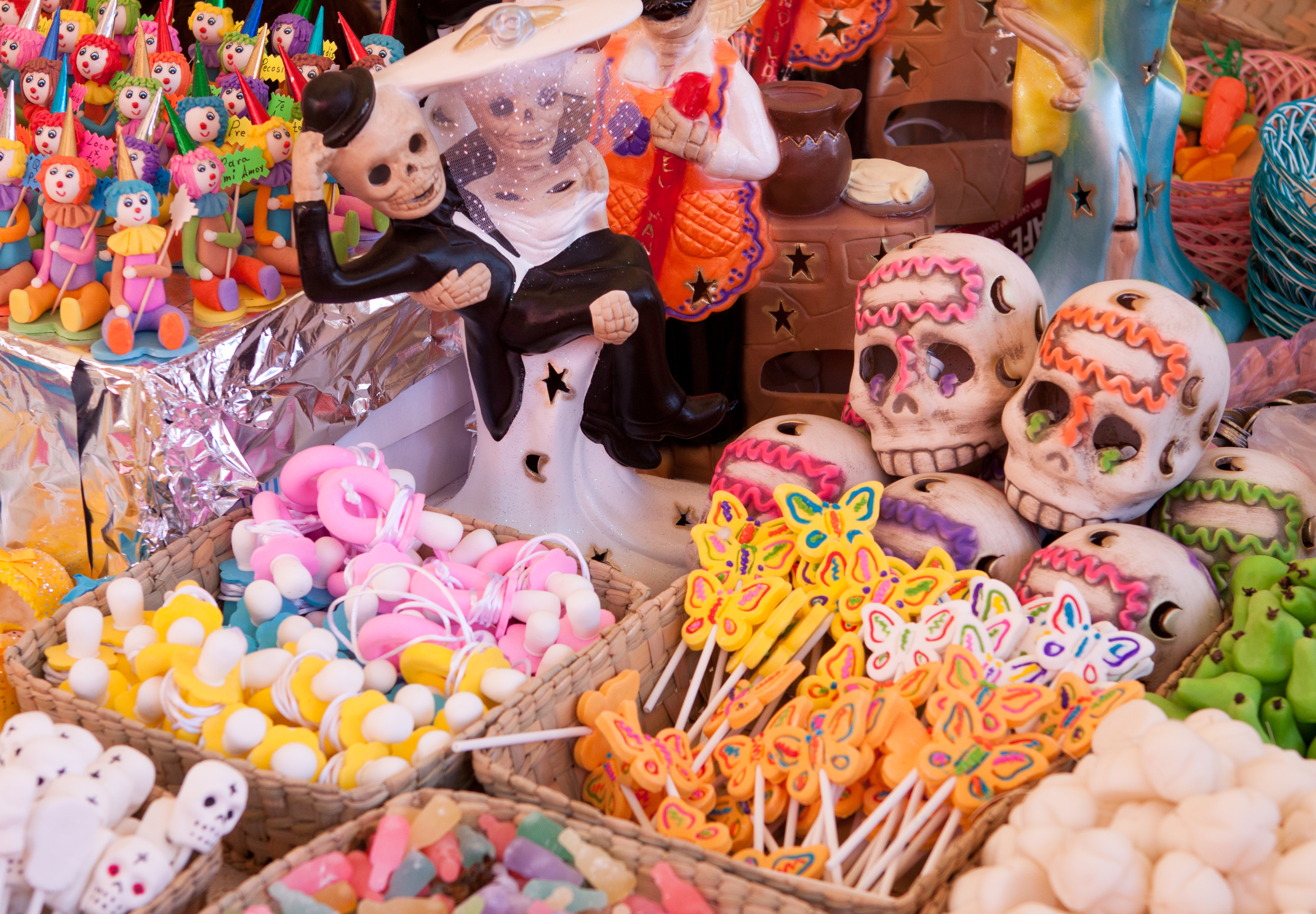|
Alfeñique
Alfeñique is a type of confection or sweet originating in Spain molded into a long or twisted shape made of cane sugar together with other ingredients. This sweet has been used in Hispanic America in folkloric events since colonial times. The alfeñique was a typical sweet of Islamic Spain, known as "Al-Fanid", which was warm and wet and used to treat coughs. In the Kingdom of Granada, it was made of sugar, water, honey and almond oil, stretched to created a viscous paste. Alfeñique figures, especially calaveras (known in the US as Sugar Skulls), are widely created in Mexico for the Day of the Dead celebrations in November. Alfeñiques in Mexico Today, the main production center for alfeñique figures are Toluca, San Miguel de Allende and Guanajuato. Today, the paste is used to form hundreds of types of shapes which include rabbits, lions, ducks, doves, cows, bulls, donkeys, pigs, frogs, horses, deer, angels, skulls and coffins. The art form has taken on more elaborate scul ... [...More Info...] [...Related Items...] OR: [Wikipedia] [Google] [Baidu] |
Alfeñique Fair
The Alfeñique fair or feria del Alfeñique is an annual event that takes place in the city of Toluca, Mexico in which vendors sell traditional sugar skulls with names labeled on the forehead, as well as candy in a variety of shapes, in order to celebrate the Mexican holiday Día de Muertos (Day of the Dead). Chocolate and sugar skulls are used to decorate altars dedicated to the dead during the celebration. The fair starts in the middle of October and lasts up to the beginning of November. Hundreds of people sell their wares at Los Portales, a series of arches surrounding the so-called place, where people can go and buy their own skulls for their altars. Every year a contest takes places in order to give a prize to the best candy skull and to the best decorated business. Alfeñique is an Arabic word "alfainid”. This word was referred to the preparation of a pastry of cooked sugar stretched into very thin layers. The alfeñique came along with the Spanish and then the aztecs made ... [...More Info...] [...Related Items...] OR: [Wikipedia] [Google] [Baidu] |
Puebla
Puebla ( en, colony, settlement), officially Free and Sovereign State of Puebla ( es, Estado Libre y Soberano de Puebla), is one of the 32 states which comprise the Federal Entities of Mexico. It is divided into 217 municipalities and its capital is the city of Puebla. It is located in East-Central Mexico. It is bordered by the states of Veracruz to the north and east, Hidalgo, México, Tlaxcala and Morelos to the west, and Guerrero and Oaxaca to the south. The origins of the state lie in the city of Puebla, which was founded by the Spanish in this valley in 1531 to secure the trade route between Mexico City and the port of Veracruz. By the end of the 18th century, the area had become a colonial province with its own governor, which would become the State of Puebla, after the Mexican War of Independence in the early 19th century. Since that time the area, especially around the capital city, has continued to grow economically, mostly through industry, despite being the scene o ... [...More Info...] [...Related Items...] OR: [Wikipedia] [Google] [Baidu] |
State Of Mexico
The State of Mexico ( es, Estado de México; ), officially just Mexico ( es, México), is one of the 32 federal entities of the United Mexican States. Commonly known as Edomex (from ) to distinguish it from the name of the whole country, it is the most populous, as well as the most densely populated, state in the country. Located in South-Central Mexico, the state is divided into 125 municipalities. The state capital city is Toluca de Lerdo ("Toluca"), while its largest city is Ecatepec de Morelos ("Ecatepec"). The State of Mexico surrounds Mexico City on three sides and borders the states of Querétaro and Hidalgo to the north, Morelos and Guerrero to the south, Michoacán to the west, and Tlaxcala and Puebla to the east. The territory that now comprises the State of Mexico once formed the core of the Pre-Hispanic Aztec Empire. During the Spanish colonial period, the region was incorporated into New Spain. After gaining independence in the 19th century, Mexico City w ... [...More Info...] [...Related Items...] OR: [Wikipedia] [Google] [Baidu] |
Calavera
A calavera (Spanish language, Spanish – for "skull") is a representation of a human skull. The term is most often applied to edible or decorative skulls made (usually by hand) from either sugar (called Alfeñiques) or clay, used in the Mexican celebration of the Day of the Dead ( es, Día de Muertos) and the Roman Catholic holiday All Souls' Day. ''Calavera'' can also refer to any artistic representations of skulls, such as the lithographs of José Guadalupe Posada. The most widely known ''calaveras'' are created with cane sugar and are decorated with items such as colored foil, icing, beads, and feathers. They range in multiple colors. Traditional methods for producing ''calaveras'' have been in use since the 1630s. The skulls are created either for children or as offerings to be placed on altars known as ''ofrendas'' ("offerings") for ''Día de Muertos'', which has roots in the Aztec, Mayan people, Mayan, and Toltec cultural celebration of the "Day of the Dead". The traditi ... [...More Info...] [...Related Items...] OR: [Wikipedia] [Google] [Baidu] |
San Miguel De Allende
San Miguel de Allende () is the principal city in the municipality of San Miguel de Allende, located in the far eastern part of Guanajuato, Mexico. A part of the Bajío region, the city lies from Mexico City, 86 km (53 mi) from Querétaro, and from the state capital of Guanajuato. The city's name derives from two persons: 16th-century friar Juan de San Miguel, and a martyr of Mexican Independence, Ignacio Allende, who was born in a house facing the city's central plaza. San Miguel de Allende was also a critical epicenter during the historic Chichimeca War (1540–1590) where the Chichimeca Confederation defeated the Spanish Empire in the initial colonization war. Today, an old section of the town is part of a proclaimed World Heritage Site, attracting thousands of tourists and new residents from abroad every year. At the beginning of the 20th century, the town was in danger of becoming a ghost town after an influenza pandemic. Gradually, its Baroque/ Neoclassical col ... [...More Info...] [...Related Items...] OR: [Wikipedia] [Google] [Baidu] |
Oaxaca
Oaxaca ( , also , , from nci, Huāxyacac ), officially the Free and Sovereign State of Oaxaca ( es, Estado Libre y Soberano de Oaxaca), is one of the 32 states that compose the political divisions of Mexico, Federative Entities of Mexico. It is divided into municipalities of Oaxaca, 570 municipalities, of which 418 (almost three quarters) are governed by the system of (customs and traditions) with recognized local forms of self-governance. Its capital city is Oaxaca de Juárez. Oaxaca is in southwestern Mexico. It is bordered by the states of Guerrero to the west, Puebla to the northwest, Veracruz to the north, and Chiapas to the east. To the south, Oaxaca has a significant coastline on the Pacific Ocean. The state is best known for #Indigenous peoples, its indigenous peoples and cultures. The most numerous and best known are the Zapotec peoples, Zapotecs and the Mixtecs, but there are sixteen that are officially recognized. These cultures have survived better than most others ... [...More Info...] [...Related Items...] OR: [Wikipedia] [Google] [Baidu] |
Calaveritas De Dulce
Calaveritas ("little skulls" in Spanish; formerly, Upper Calaveritas) is an unincorporated community in Calaveras County, California. It sits on the banks of the Calaveritas Creek at an elevation of 1,109 feet (338 m) above sea level and is located at . The community is in ZIP code 95249 and area code 209. Founded by Mexicans in 1849, the mining camp was relatively successful and by 1853, Calaveritas was well established, with one livery stable, two butcher shops, several general stores, restaurants, saloons, gambling halls, and fandango houses. Notorious bandit Joaquin Murrieta was supposedly a frequent visitor to the latter two. The town reached its peak in 1857, with an estimated population of around 800, the majority being Mexican or Chinese, but on August 3, 1858, a fire destroyed some of the buildings. By this time, the gold production had declined and some of its inhabitants moved to other locales. The town today is registered as California Historical Landmark A C ... [...More Info...] [...Related Items...] OR: [Wikipedia] [Google] [Baidu] |
León, Guanajuato
() , coordinates = , subdivision_type = Country , subdivision_name = , subdivision_type1 = Political divisions of Mexico, State , subdivision_name1 = , established_title = Founded , established_date = January 20, 1576 , established_title1 = Founded as , established_date1 = ''Villa de León'' , founder = Martín Enríquez de Almanza , leader_party = , leader_title = Mayor , leader_name = Alejandra Gutiérrez Campos , area_land_km2 = 1219.67 , elevation_m = 1815 , population_total = 1721199 , population_footnotes = , population_as_of = 2020 Census , pop_est_as_of = 2020 , pop_est_footnotes = , population_est = 1721199 , p ... [...More Info...] [...Related Items...] OR: [Wikipedia] [Google] [Baidu] |
Guanajuato, Guanajuato
Guanajuato () is a city and municipal seat of the municipality of Guanajuato in central Mexico and the capital of the state of the same name. It is part of the macroregion of the Bajío. It is in a narrow valley, which makes its streets narrow and winding. Most are alleys that cars cannot pass through, and some are long sets of stairs up the mountainsides. Many of the city's thoroughfares are partially or fully underground. The historic center has numerous small plazas and colonial-era mansions, churches, and civil constructions built using pink or green sandstone. The city historic center and the adjacent mines were proclaimed a World Heritage Site by UNESCO in 1988. The growth of Guanajuato resulted from the abundantly available minerals in the mountains surrounding it. The mines were so rich that the city was one of the most influential during the colonial period. One of the mines, La Valenciana, accounted for two-thirds of the world's silver production at the height of its pr ... [...More Info...] [...Related Items...] OR: [Wikipedia] [Google] [Baidu] |
Toluca
Toluca , officially Toluca de Lerdo , is the States of Mexico, state capital of the State of Mexico as well as the seat of the Municipality of Toluca. With a population of 910,608 as of the 2020 census, Toluca is the fifth most populous city in Mexico. The city forms the core of the Greater Toluca metropolitan area, which with a combined population of 2,347,692 forms the Metropolitan areas of Mexico, fifth most populous metropolitan area in the country. Located southwest of Mexico City, the city's rapid growth stems largely from its proximity to the capital. Etymology When Toluca was founded by the Matlatzinca people, Matlatzincas, its original name was ''Nepintahihui'' (land of corn). The current name is based on the Náhuatl name for the area when it was renamed by the Aztecs in 1473. The name has its origin in the word ''tollocan'' that comes from the name of the god, ''Tolo'', plus the locative suffix, ''can'', to denote "place of Tolo". It is also referred to in a number o ... [...More Info...] [...Related Items...] OR: [Wikipedia] [Google] [Baidu] |


